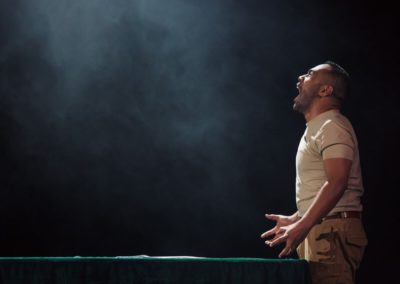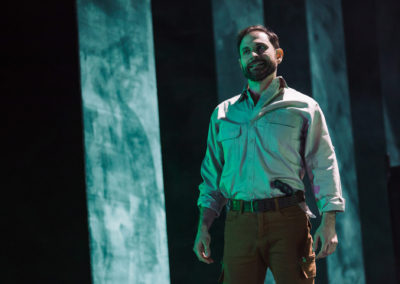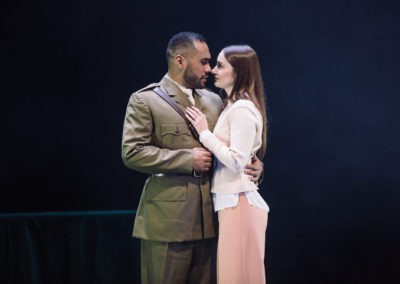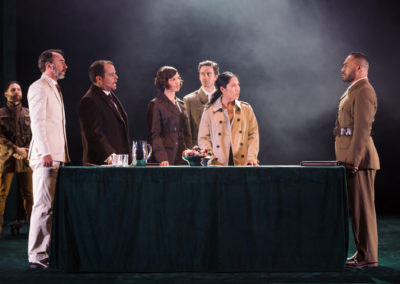Othello | Bell Shakespeare
Othello is a play disturbing in cruelty and otherness that is both archaic and chillingly contemporary. Peter Evan’s touring production blurs the dichotomy of the play – seen and unseen, puppeteer and pawn – into a tragedy of isolation and impulse from which no character is able to escape.
There is a musicality to Ray Chong Nee’s verse, particularly as the composed, regal general of the opening acts. His enraptured, heartfelt description of Desdemona as she enters has an almost ethereal quality, causing the destruction of their relationship to be even more tragic. While calm on the surface, Othello’s complete stillness at the pervasive otherness of him that invades even compliments, steadily builds into a breakdown. Rather than a sense of naivety, the tragedy comes in clinging to the advice of his only ‘true’ friend while it appears his glimpse of happiness surrenders to the world that shuns him.
Yalin Ozucelik’s scheming ‘honest’ Iago commands both the audience’s frequent laughter and horrified silence. But in a fascinating break from the character’s tradition, he is never completely in control, appearing as more of a gambling improviser than a calm mastermind. Watching him have to work through his plans places him on a more even playing field with those he manipulates. With even Iago shocked at his success, it heartbreakingly highlights the moments where another could have ended his schemes.
Peter Evan’s touring production blurs the dichotomy of the play – seen and unseen, puppeteer and pawn – into a tragedy of isolation and impulse from which no character is able to escape.
Gentle but not delicate, Elizabeth Nadden’s Desdemona’s warmth and ease within the political and militant world allows the young women described prior to the play to thrive. Watching her active sympathy towards Cassio and confident, flirtatious wooing of Othello mirrors the assertiveness that began their courtship. The shattering of her faith in the good of others is gut-wrenching, shrinking into horrified disbelief before her finale savage fight to survive.
Joanna Downing’s Emilia commands the stage in the final acts, critiquing Desdemona’s absolute dismissal of unfaithfulness with a playful wit before struggling to hold back tears as she considers her own fate. And while her most famous speech is a savage critique on the rampant sexism within the play, she herself is not free of discrimination, being quick to jump on accusations hurled at Bianca. Despite a limited amount of stage time, Alice Keohavong’s portrayal of her almost mirrors Othello, dismissed by society and suspicious that their lover is compliant in the society that mocks and scorns them – a similarity enhanced by being the only other character portrayed by a person of colour. Cassio’s casual dismissal of her stands at odds with the warmth he conveys to those around him, potentially combining with his early compulsive flirting to add support to Iago’s attacks on him. But his loyalty and admiration to Othello and almost catatonic regret almost shames the audience for their belief in Iago’s portrait of him, yet still shows how pervasive the undercurrents of casual oppression run within society.
Michael Hankin’s costuming is simple yet effective, with a majority of the cast clad in timeless khaki uniforms. With Emilia dressing in the same fashion, it makes Desdemona’s soft, airy and more comfortable clothing stand out amongst the soldiers that surround her and emphasises Emilia’s more weary, worldly nature. But it is Hankin’s set design that takes centre stage, tackling the enormous task of designing for almost thirty different theatre’s with limited bump in time. Thick, rich green velvet dominated the stage, coating the floor and rising up into the looming pillars. It’s reflective nature leads to a seamless collaboration with Paul Jackson’s lighting design, shifting between glimmering luxury, a whirling storm and a deep abyss. But looking down on the stage following the play’s horrifying conclusion, it becomes hard to think of it of anything but a tomb.
There is no romanticisation or softening of the deaths, and final words are pronounced at knife-point. Rather than redemption for atrocities at the cost of demeaning those who lie silent at their feet, it offers a tragic finale of raw pain.
Through a majority of the performance, changes in location and mood are conveyed by the spinning desk, creating a constant sense of motion that drives the play’s pace forward and works particularly well with the intimate circular stage. The adaptable simplicity of it makes the introduction of a final set piece in the final scenes all the more ominous, with the silken canopy’s billowing, transparent softness becoming more eerie and suffocating than the pillars that soar into darkness. In a similar sense, while a dull roar lurks under much of the production, the most frightening moments come with Desdemona’s despairing, fragile song cutting through empty silence.
Of the cuts to the script, the most prominent comes in the ending. There is no romanticisation or softening of the deaths, and final words are pronounced at knife-point. Rather than redemption for atrocities at the cost of demeaning those who lie silent at their feet, it offers a tragic finale of raw pain.






